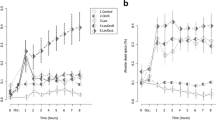Abstract
Sixteen anaesthetized rabbits were subjected to tracheostomy and lung damage produced by the instillation of 4.5 ml/kg hydrochloric acid (pH 1.5) into the trachea. Half of the animals were ventilated with a positive end-expiratory pressure (PEEP) of 3 cmH2O and half with a PEEP of 10 cmH2O for 5 h, the mean airway pressure being kept at 12 cmH2O by adjustment of the end-inspiratory pause time. Pressure-volume curves were recorded every hour. Although the arterial PO2 values and compliance above the inflection point on the pressure-volume curve were greater in the group submitted to 10 cmH2O PEEP, there were no significant differences between the groups in terms of survival and histological findings.
Similar content being viewed by others
References
Lachmann B, Johnson B, Lindroth M, Robertson B (1982) Modes of artificial ventilation in severe respiratory distress syndrome: lung function and morphology in rabbits after washout of alveolar surfactant. Crit Care Med 10:724–732
Hamilton PP, Onayemi A, Smyth JA, Gillan JE, Cutz E, Froese AB, Bryan AC (1983) Comparison of conventional and high-frequency ventilation: oxygenation and lung pathology. J Appl Physiol 55:131–138
Sandhar BK, Niblett DJ, Argiras EP, Dunnill MS, Sykes MK (1988) Effects of positive end-expiratory pressure on hyaline membrane formation in a rabbit model of the neonatal respiratory distress syndrome. Intensive Care Med 14:538–546
Niblett DJ, Sandhar BK, Dunnill MS, Sykes MK (1989) Comparison of the effects of high frequency oscillation and controlled mechanical ventilation on hyaline membrane formation in a rabbit model of the neonatal respiratory distress syndrome. Br J Anaesth 62:628–636
Argiras EP, Blakeley CR, Dunnill MS, Otremski S, Sykes MK (1987) High PEEP decreases hyaline membrane formation in surfactant deficient lungs. Br J Anaesth 59:1278–1285
Dorrington KL, McRae KM, Gardaz JP, Dunnill MS, Sykes MK, Wilkinson AR (1989) A randomized comparison of total extracorporeal CO2 removal with conventional mechanical ventilation in experimental hyaline membrane disease. Intensive Care Med 15:184–191
Kawano T, Mori S, Cybulsky M, Burger R, Ballin A, Cutz E, Bryan C (1987) Effect of granulocyte depletion in a ventilated surfactant-depleted lung. J Appl Physiol 62:27–33
Wyszogrodski I, Kyei-Aboagye K, Taeusch Jr HW, Avery ME (1975) Surfactant inactivation by hyperventilation: conservation by endexpiratory pressure. J Appl Physiol 38:461–466
Faridy EE, Permutt S, Riley RL (1966) Effect of ventilation on surface forces in excised dogs' lungs. J Appl Physiol 21:1435–1462
Faridy EE (1976) Effect of ventilation on movement of surfactant in airways. Respir Physiol 27:323–334
Webb HH, Tierney DF (1974) Experimental pulmonary edema due to intermittent positive pressure ventilation with high inflation pressures. Protection by positive end-expiratory pressure. Am Rev Respir Dis 110:556–565
Greenfield LJ, Singleton RP, McCaffree DR, Coalson JJ (1969) Pulmonary effects of experimental graded aspiration of hydrochloric acid. Ann Surg 170:74–86
Popper H, Juettner F, Pinter J (1986) The gastric juice aspiration syndrome (Mendelson syndrome). Virchows Arch[A] 409:105–117
Pesenti A, Kolobow T, Buckhold DK, Pierce JE, Huang H, Chen V (1982) Prevention of hyaline membrane disease in premature lambs by apneic oxygenation and extracorporeal carbon dioxide removal. Intensive Care Med 8:11–17
Rubin S, Davidson JT, Eyal Z (1971) The acute effect of acid aspiration on lung mechanics and gas exchange in the rabbit. Isr J Med Sci 7:1271–1275
Rinaldo JE, Rogers RM (1982) Adult respiratory-distress syndrome: changing concepts of lung injury and repair. N Engl J Med 306:900–909
Frostell C, Blomqvist H, Wickerts CJ (1987) Effects of PEEP on extravascular lung water and central blood volume in the dog. Acta Anaesthesiol Scand 31:711–716
Author information
Authors and Affiliations
Rights and permissions
About this article
Cite this article
Sohma, A., Brampton, W.J., Dunnill, M.S. et al. Effect of ventilation with positive end-expiratory pressure on the development of lung damage in experimental acid aspiration pneumonia in the rabbit. Intensive Care Med 18, 112–117 (1992). https://doi.org/10.1007/BF01705044
Received:
Accepted:
Issue Date:
DOI: https://doi.org/10.1007/BF01705044




